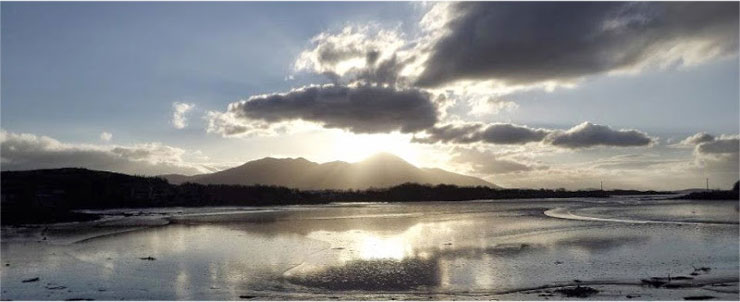Clew Bay Archeological Trail

Stage 1 Westport, Cathair na Mart (The Stone Fort of the Beeves)
The Westport section includes 4 sites:
1: CLEW BAY HERITAGE CENTRE
Located in a 19th century building at the far end of the Quay, the Clew Bay Heritage Centre traces the history of the planned town of Westport and Clew Bay area from pre-Christian times to the present.
Artefacts, documents and photographs connected with the general Westport area and related to the sites along the Clew Bay Archaeological Trail provide a basis for the presentation of local history, customs and traditions.
2: BOHEH STONE, BOTH SHEITHE (THE SKINHIDE HUT)
At first glance the Boheh Stone appears to be a pile of stones but a closer inspection reveals that the stones are covered by cup and ring markings.
It is considerate one of the finest examples of neolithic rock art in Ireland and the stones have been declared a national monument. These carvings date back to the late Stone Age/Early Bronze Age (the same era of New Grange).
At a later stage the Boheh Stone, located along the pilgrimage route Tochar Phadraic, was Christianised and called St Patrick’s Chair after the Saint.
THE ROLLING SUN
From Boheh Stone the view of Croagh Patrick is wide and broad. In 1989, Gerry Bracken, a local archaeologist from Westport, discovered a connection between the stone and the mountain. He noted that from this stone on April 18th and August 24th the setting sun appears to roll down its northern shoulder and doesn’t disappear behind the mountain.
According to tradition, August 24th is St Bartholomew’s Day, the first day of Autumn and harvesting season, while early men may have selected the April 18th to mark the sowing season and that’s how these two dates, which also split the year in three equal part, link the stone with the sacred mountain.
3: CARROWNALURGAN RINGFORT, CEATHRU NA LORGAN (QUARTER OF THE LOW LONG HILL)
Carrownalurgan ringfort, situated on a ridge to the right of the Westport/Louisburg Road, has a panoramic view. It dates from 500 to 1000 AD.
Usually circular in shape ringforts, were farmsteads enclosed by an earthen bank (Raths and Lios) or by a stone wall (Cashels, Duns and Cahers). Houses took up a small area of the fort, the most of it was used for sheltering animals at night or in wintertime.
This ring fort had diameters of 38m north-south by 36m east-west and was located on the highest point of a ridge offering a full view over the countryside.
Here there is also a limestone slab, possibly an altar stone. It dated back to 1723 and carved with a Latin inscription requesting the wayfarer to pray for the soul of Peter Browne.
4: AUGHVAL GRAVEYARD AND CHURCHES, AN NUACHONGBHAIL (THE NEW FOUNDATION)
Aughaval graveyard is the main cemetery in Westport parish. In the past it was used by both Catholics and Protestants. There is also the “Altoir na bPaisti” or Altar of the Children erected to the memory of the children died before their Baptism.
This graveyard once belonged to a large and important monastery dating back to the 11th century. There were two churches, the first (nowadays lost) lied on the northern side of West Road and the second, still visible in the graveyard, is on the southern side of the road.
In this little stone church the most interesting feature is the square-headed doorway, one of the few examples of early church architecture in West Mayo.
Here in 1131 AD the son of Donal O’Dowda killed O’Maille but, through the miracle of St Columcille, the murderer died within three months killed by his own spear.
According to legend here was a cursing stone, called “Leac Cholumbcille’, which was used to wish bad luck on enemies. However the stone was broken by order of the priest in 18th century.
In the graveyard there is another interesting stone ‘Gloonpatrick or Patrick’s Knee’. The stone has a round hollow, where it is said the Saint knelt. It is located to the left of the stile into the graveyard. Tradition tells the stone never goes dry.
These stones are called Bullaun Stones and used to be common on monastic sites. Archaeologists think they were associated with metalworking.
